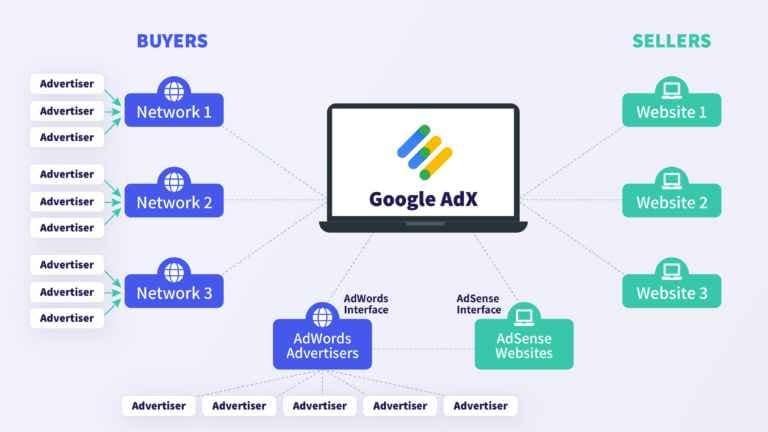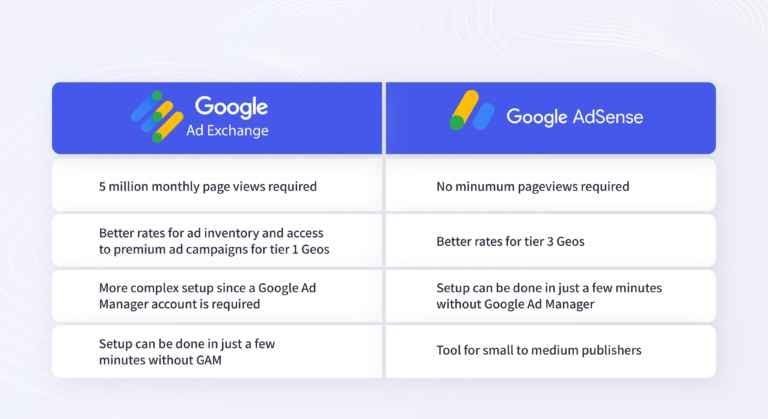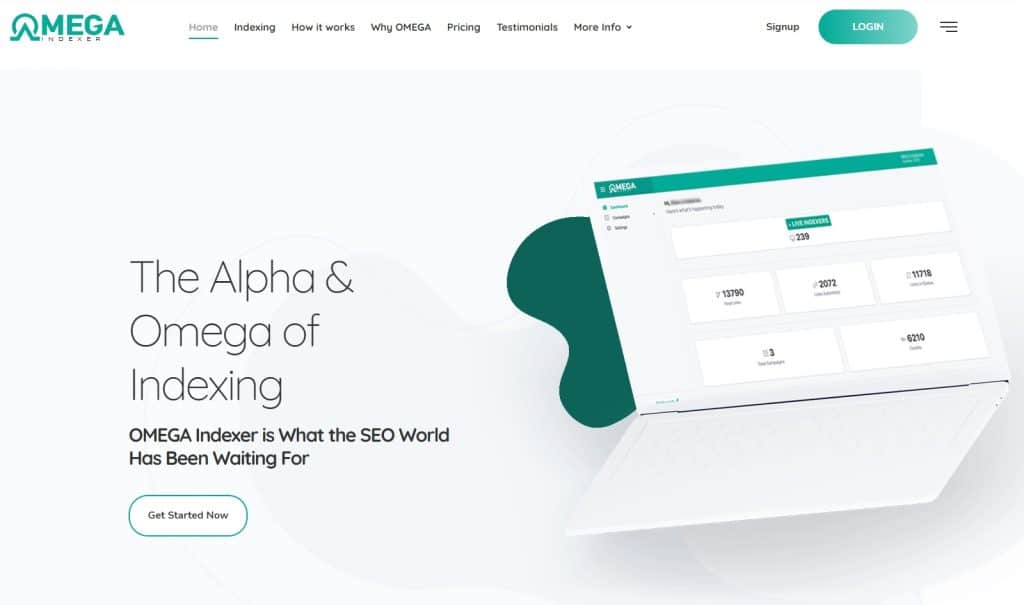If you’re a website owner or a blogger, you’re probably familiar with the terms Adsense and display ad networks. These two are famous online advertising networks used to monetize your website. However, the question remains: which one is better? Is it Adsense, Google’s famous ad platform, or display ad networks that provide multiple advertising options? With so many options available, it’s tough to determine which one provides better opportunities for your website. Today, we’ll compare Adsense vs. display ad networks to help you make an informed decision. As an industry expert in online advertising, let me guide you through this comparison, so you can choose the best option for your website.
Comparison Table: Adsense vs. Display Ad Networks
| Features/Specifications | Adsense | Display Ad Networks |
|---|---|---|
Ownership | Owned by Google | Owned by various network companies |
Ad Types | Text, display, mobile, link units, matched content | Banners, pop-ups, native, interstitials, video |
Payout Rates | Variable payout rates, depending on ad type and niche | Fixed or variable payout rates, depending on network |
Targeting Options | Geographical, contextual, interest-based, demographic | Geographical, behavioral, contextual, retargeting |
Ad Quality | High quality, as ads are vetted by Google | Depends on network and advertiser quality standards |
Approval Process | Stringent approval process | Less stringent approval process |
Ad Placement | Flexible, can be placed anywhere on site | Depends on network restrictions and requirements |
Reporting | Robust reporting system, with detailed metrics and analytics | Varies depending on network, but generally has less detailed reporting |
Ease of Use | Easy to use, with guidance and support from Google | Varies depending on network, but may require more setup and management |
Overall, Adsense offers better opportunities for publishers due to its high quality ads, robust reporting, and flexible ad placement options. However, display ad networks may be a better option for publishers with specific targeting needs or higher payout rates. Ultimately, the best choice will depend on the individual needs and goals of the publisher.

Adsense vs. Display Ad Networks: Which Offers Better Opportunities?
Overview
Adsense and display ad networks are two widely used advertising platforms that marketers and publishers can use to monetize their websites. Adsense is an ad publishing platform developed by Google that allows publishers to display targeted ads on their websites. Display ad networks, on the other hand, help advertisers reach their target audiences across multiple websites by showing display ads on them.
Pros and Cons
Adsense
Pros:
- Easy to set up and use
- Has a large pool of advertisers and publishers
- Offers a diverse range of ad formats
- Has high payout rates for publishers
- Provides detailed analytics and reporting
Cons:
- Strict policies and guidelines that can result in account suspension or termination
- Revenue heavily dependent on ad clicks and impressions
- Possible revenue fluctuations due to seasonality and market changes
Display Ad Networks
Pros:
- Offers access to a large pool of advertisers and publishers
- Provides advanced targeting options
- Allows for the creation of custom ad campaigns
- Offers more control over ad placements and pricing
- Can provide higher CPM rates compared to Adsense
Cons:
- Requires more expertise and resources to manage campaigns effectively
- May have lower overall payout rates compared to Adsense
- Can be more expensive for advertisers due to higher ad rates and fees
- May require multiple ad networks to achieve desired reach and results
Key Points and Features
Adsense
Key Points:
- Easy to set up and use
- Diverse range of ad formats, including display ads, text ads, and native ads
- Revenue generated through ad clicks and impressions
Features:
- Customizable ad units
- Ad preview tool
- Mobile optimization
- Ad targeting
- Performance analytics and reporting
Display Ad Networks
Key Points:
- Allows for advanced targeting options, including geographic, demographic, and behavioral targeting
- Offers more control over ad placements and pricing
- Provides access to a larger pool of advertisers and publishers
Features:
- Custom ad campaign creation
- Ad creative optimization
- Tracking and reporting tools
- Real-time bidding
- Ad network optimization
Performance and Research
According to research by MonetizePros, Adsense has an average CPM rate of $1.41, with the highest performing ad formats being display ads and link units. The study also found that Adsense CPC rates vary widely depending on the website niche and audience.
For display ad networks, the average CPM rate can range from $0.50 to over $5, depending on the targeting and placement of the ads. However, a study by AdReactor found that display ad networks typically provide lower overall revenue compared to Adsense.
Reasons to Consider/Ignore
Adsense
Reasons to consider:
- Easy to set up and use
- Diverse range of ad formats
- High payout rates for publishers
Reasons to ignore:
- Strict policies that can result in account suspension or termination
- Possible fluctuations in revenue due to seasonality and market changes
- Revenue heavily dependent on clicks and impressions
Display Ad Networks
Reasons to consider:
- Advanced targeting options
- More control over ad placements and pricing
- Provides access to a larger pool of advertisers and publishers
Reasons to ignore:
- More expertise and resources required to manage campaigns effectively
- May have lower overall payout rates compared to Adsense
- Can be more expensive for advertisers
Suggestions for Potential Users
For publishers with smaller websites or blogs, Adsense can be a great option for monetization, as it is easy to set up and provides competitive payout rates. For larger websites or those looking for more control over ad placements and pricing, display ad networks can offer more flexibility and advanced targeting options. However, managing display ad campaigns can be more complex and may require additional resources and expertise. Ultimately, the decision between Adsense and display ad networks will depend on the specific needs and goals of the publisher or advertiser.

Guidelines for Using Adsense vs. Display Ad Networks: Which Offers Better Opportunities?
1. Understand the difference between Adsense and Display Ad Networks
Adsense is Google’s advertising platform that allows website owners to display targeted ads on their site and earn revenue based on clicks or impressions. Display Ad Networks, on the other hand, refers to a group of independent advertising networks that offer similar services.
2. Consider your website’s niche and audience
Certain niches may perform better with Adsense or Display Ad Networks. Consider your audience’s demographics, interests, and behavior to determine which advertising platform is more suitable for your website.
3. Test and monitor ad performance regularly
Experiment with different ad formats, sizes, and placements to determine what works best for your website. Monitor ad performance regularly and make adjustments as needed to optimize revenue.
How-To Questions About Adsense vs. Display Ad Networks: Which Offers Better Opportunities?
1. How To Decide Whether Adsense or Display Ad Networks Offer Better Opportunities?
Answer: To decide which one offers the better opportunity for you, you need to consider a few factors. Some of the factors are the type of website you have, your audience demographics, and the monetization goals you have in mind. Adsense is best for publishers who have a high volume of traffic, while Display Ad Networks are better suited for publishers with a niche audience. A successful publisher needs to analyze the pros and cons of both options to determine the best fit.
2. How To Get Approved for Google Adsense?
Answer: To get approved for Google Adsense, you must have a website with original and high-quality content. Your website should also comply with Google’s terms of service, user content policy, and AdSense programme policies. Make sure to read the policies carefully and follow all the guidelines for AdSense approval. Once you are ready, you can submit an application and wait for Google’s approval.
3. How To Maximize Your Display Ad Network Earnings?
Answer: There are a few ways to maximize your display ad network earnings. Firstly, optimize your website for ad placement and graphic design. Secondly, analyze your website’s traffic sources to ensure that your audience is profitable. Thirdly, test and optimize your ad network partnerships regularly to understand which ones perform best while delivering better earnings, higher CPMs, and fill rates. Fourthly, do not hesitate to experiment with programmatic tools that can help improve your ad delivery and performance.
4. How To Increase Your Adsense Earnings?
Answer: To increase your Adsense earnings, aim to increase organic traffic to your website. Secondly, experiment with ad placement within your website to improve user visibility. Thirdly, experiment with different ad formats and sizes to understand which ones work best for your website. Fourthly, ensure that your website’s design is mobile-friendly to avoid losing mobile users and maximizing your income. Lastly, never cheat Adsense because they have a very strict policy for invalid click activity.
5. How To Choose the Right Display Ad Network?
Answer: To choose the right display ad network, identify your website’s niche audience demographics. Then, conduct research on display ad networks within that niche to find out their market position, reputation, and payout structure. Finally, experiment with a few networks to understand which one best fits your revenue goals, and delivers high-quality ads to your website. Do not hesitate to test various networks to find the right fit.
Frequently Asked Questions (FAQs): Adsense vs. Display Ad Networks
1. What is the difference between Adsense and display ad networks?
Google Adsense is a program that allows website owners to monetize their content by placing Google ads on their websites, while display ad networks are third-party platforms that offer ad inventory from multiple sources to advertisers looking to reach a specific audience.
2. Which platform offers better revenue opportunities?
It largely depends on your website’s traffic and niche. Adsense tends to offer higher revenue for websites with high traffic and clicks, while display ad networks may offer better rates for niche websites that have a specific audience that advertisers are willing to target.
3. Which platform has better ad quality?
Both Adsense and display ad networks offer high-quality ads, but Adsense may have a slight edge as it uses Google’s advanced algorithms and AI to display relevant and high-quality ads on your website.
4. Which platform is easier to set up and use?
Adsense is relatively easier to set up, as it is a Google product and can be seamlessly integrated with your website using a few lines of code. Display ad networks, on the other hand, require more effort in terms of setting up an account, choosing the right network, and integrating their ad code into your website.
5. Which platform offers more control over the ads displayed on my website?
Adsense offers limited control over the ads displayed on your website, as Google’s algorithms decide which ads to display. Display ad networks offer greater control over the ads displayed on your website, as you can choose the ad network, set your preferred ad size and format, and filter out unwanted ads.
In conclusion, both Adsense and display ad networks offer great opportunities for publishers to monetize their websites and generate revenue. Adsense, being the most popular, is easier to set up and provides reliable and consistent income. Display ad networks, on the other hand, offer more flexibility and control over ad content, as well as potentially higher revenue.
It’s important to consider various factors such as website niche, traffic, and audience demographics, when choosing between Adsense and display ad networks. Ultimately, the decision boils down to personal preferences and goals.
Our recommendation is to start with Adsense as it’s a great platform for beginners, then experiment with different display ad networks to find one that suits your needs and goals. With the right approach, both Adsense and display ad networks offer excellent opportunities for publishers to generate revenue and succeed online.

One of the Top SEO Consultants In Bangladesh. In 7 years of my career, I have worked with more than 80 brands & uncountable love from my SEO clients. To provide SEO service I have an in-house SEO team.




